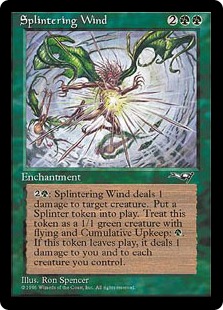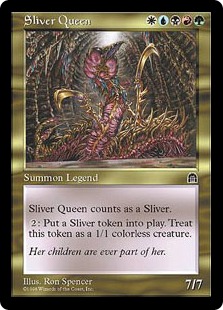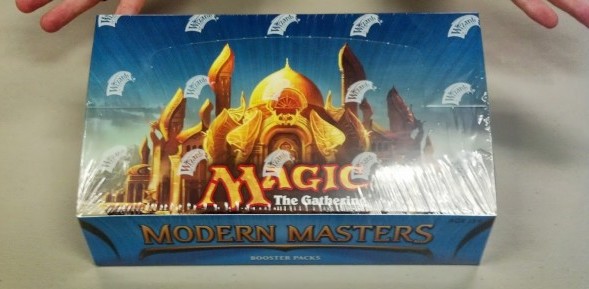Note: Given that this past weekend was the release of Modern Masters 2015, and in recognition that Monday, May 25th is a US holiday, please enjoy this article on how Modern Masters came to be. It was originally posted on 6/17/13.
![]()
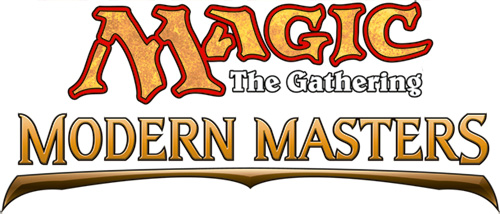
At the beginning of June, Wizards of the Coast did something they haven’t attempted since 10th Edition: they released a set comprised entirely of reprints in the special edition of Magic: the Gathering called Modern Masters. Modern Masters is unique, though, in that it isn’t a throwback to the core sets of old. Rather, it is purely a set of reprints of popular cards, and it was designed with three purposes in mind:
- It wants to get more cards into circulation for use in the Modern tournament format, to help address rising costs of some popular cards. (Modern is comprised of all sets with the, well, modern frame template – being 8th Edition forward.)
- It aims to get cards into the hands of casual players who may have missed out on the sets that they originally came from.
- It was designed to be a fully functional set in order to draft with.
Recently we were lucky enough to be able to do draft Modern Masters, and we’ll be talking soon about whether it lives up to its lofty goals. But first, we start off with a lesson on how we got here exactly.
For you see, we have been here once before . . .
1993-1994: The Panic Years
| Approximate Early Print Runs: |
|
Expansion Sets: Arabian Nights (Dec. 1993): 5 Million Cards Antiquities (March 1994): 15 Million Cards Legends (June 1994): 35 Million Cards The Dark (Aug. 1994): 75 Million Cards Fallen Empires (Nov. 1994): 350 Million Cards Chronicles (Aug. 1995): 200 Million Cards Core Sets: Revised (April 1994): 500 Million Cards Fourth Edition (April 1995): 500 Million Cards |
Magic: the Gathering started off as an experiment to see if people would hone in on the idea of a collectible card game. It may seem silly now, as we are in the 20th year of the game’s existence, but back then things were far less clear as to whether the game would succeed or not.
After the successful printings of the game’s limited edition runs of Alpha, Beta, and Unlimited (Second Edition), there were early indicators that the game was gaining a following, but the first expansions were already being printed and rolled out before any sort of market data could be collected. Essentially, these expansions were a gamble.
The first two, Arabian Nights and Antiquities sold decently. They also had guessed print runs correctly for the release of the first major core set, Revised (Third Edition), which followed suit.
The third expansion set, Legends, was beset with a number of design and development problems, including balance issues and that it was the size of a large set but was still considered an expansion. It is only fitting that it continued these troubles all the way through production, as they highly underestimated the demand the set would have. They were so far off, in fact, that we have the now-classic tales of the set being sold out before it even hit some retail stores. Given that this was during the days when the Internet was in its infancy, it makes this scarcity story all the more impressive.
They knew by the time of release they had screwed up, but by then it was too late to order another print run. The best they could hope for was that they didn’t run into the same thing with the fourth expansion set, The Dark (spoiler: they didn’t), which was also already in production.
(Consequently, this is also why the next expansion set, Fallen Empires, was so heavily overprinted and never amounted to a set of any financial worth. After finally seeing the numbers from the first three expansions, they assumed that demand on future expansions would meet what they saw in those numbers. They had swung the pendulum too far in the other direction.)
1995: The Manic Year
As they had a chance to look over numbers from its frantic first year, one thing became evident: the game was picking up steam. The following year, in 1995, Wizards released a new core set with Fourth Edition. In it, they decided to rotate out a number of cards they thought were too powerful (such as the iconic Dual Lands). In its place, they opted to fill those slots with some popular out of print cards from its first expansions, as a means of getting more of them into rotation. Early feedback was positive.
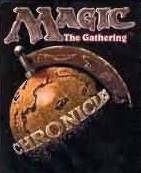 Wizards liked the idea of getting those early expansion cards into players’ hands, but they only had so many slots available in a core set. So, they decided to try to correct their mistake of not printing enough of the first three expansions by creating a new set for that fall. This would be a set containing a cross-section of reprints from the first four expansions, and it would be legal for the newly burgeoning tournament scene. While it too left out a lot of the really powerful cards, it did include a lot of fan favorites like the Elder Dragons. The set was called Chronicles.
Wizards liked the idea of getting those early expansion cards into players’ hands, but they only had so many slots available in a core set. So, they decided to try to correct their mistake of not printing enough of the first three expansions by creating a new set for that fall. This would be a set containing a cross-section of reprints from the first four expansions, and it would be legal for the newly burgeoning tournament scene. While it too left out a lot of the really powerful cards, it did include a lot of fan favorites like the Elder Dragons. The set was called Chronicles.
1995’s reprint year was a noble idea; a nod to those who got the game off the ground. From a player’s perspective, it worked wonderfully. Fans of the game were ecstatic that they could get access to a lot of cards they had missed out on, and it added to the available pool of them. It helped draw in new players, and it solidified the appreciation of a player base that Wizards wanted to hold on to. In this, it was a rousing success.
However, say you were a collector, or a store owner, and your $40 Nicol Bolas was now worth $1. Now multiply the effect across all of the common, uncommon, and rare cards reprinted in Chronicles and 4th Edition. You just lost a lot of equity in these pieces of cardboard you’re selling.
From their point of view, reprinting valuable and playable cards set a bad precedent for Wizards. These owners were angry and concerned. How would stores and collectors be able to reliably invest in Magic if their own stock could be undercut as soon as a year later? Where was the incentive to continue supporting this new game from a business standpoint? Many sellers threatened to stop carrying Magic product entirely. A few even did.
Wizards, still a young company in its own right, acknowledged that something needed to be done for sellers and collectors to be able to retain card value. (They spun the acknowledgement it on behalf of collectors, but it was sellers that were the larger issue.)
Talks were had, ideas were bandied about, arms were twisted, and, ultimately, they came up with a concept that they felt was fair middle ground. They agreed that the latter group’s complaint had merit, and for fear of alienating an important group in their distribution chain, drafted a new policy that would limit the scope of card reprints in the future.
This way, Wizards retained the important right to reprint new cards within a certain time frame, while promising that anything beyond that limit (as well as a majority of cards from existing expansions up until that point) would not be printed ever again. Period.
And that’s how we ended up with the Reserved List: arguably the most contentious decision Wizards of the Coast has ever made. Unless it was reprinted in a core set, any uncommon or rare prior to Fourth Edition, or any rare from Ice Age through Urza’s Destiny, is now forever locked away.
The Legacy’s Effect on Legacy
So, what does this all have to do with Modern Masters? Why the law of unintended consequences of course.
See, in the tournament scene there are two Eternal formats, called Legacy and Vintage. They are called Eternal formats because, with certain exceptions, they can use any card in the game’s expansive inventory. However, even though they gain access to new cards every few months, the majority of cards used competitively in the format are older cards. Specifically, they are cards on the Restricted List, and are therefore unable to be reprinted.
As each year goes by, the scarcity of many important cards to these formats increases. These cards get harder to find, and this drives up the entry cost of getting into an Eternal format. It’s been a rising complaint from their fans in recent years that the already-sizable financial burden is becoming so cost-prohibitive to prospective new players that they simply can’t join. In short: the existence of the Restricted List is slowly killing these formats. However, while the Reserved List parameters have slightly changed over the years, studies have shown that occasionally reprinting cards long out of rotation actually causes the original’s value to go up, and even many people within Wizards believe its continued existence to be largely negative, they have no intention of changing the course of events. They made a promise to hold to the Reserve List, and they’re sticking to it. It’s respectable, but we don’t have to like it. Most of us don’t.
The Eternal formats weren’t the only competitive non-Standard formats that Wizards supported either. There was also Extended. Initially, Extended behaved as an intermediate format between Standard’s two most recent blocks and Eternal’s “everything goes” model. And it was popular…for awhile.
As of fall 2005, nothing tourney legal in Extended was still on the Reserved List. Still, the general time a set stayed legal in the format was roughly seven years, and in time Wizards felt that it too was starting to become prohibitive for new players. In 2010 they shortened it to every four years, hoping to help bring new players into the format since it could ease barrier to entry. (The added benefit for them was that Wizards could offer them a higher percentage of needed product that was still available in stores.)
It didn’t quite work. It was a move that was probably too little too late. They ultimately felt that such a change wasn’t substantive enough, and in 2011 they introduced a Eternal 2.0 format to effectively replace Extended, called Modern. In Modern, everything 8th edition onward would be legal, except for an updated banned & restricted list. No rotation issues, no Reserved List, no more problems, right?. . . Right?
History Loves Repeating Itself
As is often the case, Wizards was faced with familiar issues. Interest in Modern took off, and you can guess what happened. Even with a meticulously managed banned list (to ensure that no one deck became format-warping) scarcity issues started to yet again become an issue. They knew, though, that they could never reprint powerful Modern staples in current sets. Or, at least, they didn’t want to. Many were deemed just too powerful to reintroduce to Standard. (Looking at you Tarmogoyf.) So, costs rose, barrier to entry started anew and…you’ve heard this story before.
This time, however, Wizards feels they have the tools to solve such problems. And so we have Modern Masters: the new Chronicles. Wizard’s attempt at a mea culpa for promising Modern wouldn’t be like the other tournament styles.
It’s a set solely designed to get more copies of certain cards into circulation, while at the same time bypassing having to put them in sets that would rotate through Standard.
It’s available in stores, so casual players who may have missed out on Doubling Seasons and Vedalken Shackles once again can have a shot at getting them.
And there’s no Reserved List fuss, though they are keeping the print run smaller than a normal set to appease the reseller / collector contingent.
Magic has come a long way since those rocky first couple years, and this time they hope to do a reprint set right. Does Modern Masters live up to its three intended goals?
Check back tomorrow to hear the results of our expedition into a Modern Masters draft, and our conclusions on the matter!
![]()
Do you have thoughts on Modern Masters? You can discuss this article on our social media, or contact Ryan at ryan@cardboardrepublic.com.

